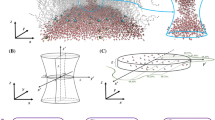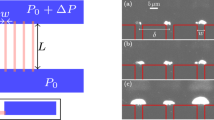Summary
Ultrastructure, formation and disappearance of endothelial pores was studied electron microscopically in several normal or experimentally changed organs. Pores being discontinuies in the endothelial wall have a very constant diameter of 500 Å. The diaphragm at the margin of the pore is in contact with only the outer lamella of the unit membrane. Pores without a diaphragm being somewhat larger (Ø ∼ 650 Å) show a smoother margin and are to be found in endothelia with dense cytoplasm. “Frustrated” pores form blind openings in vacuoles or are situated in porous endothelial folds within the vessel lumen. Pores alway are formed in flattened parts of endothelium (≦ 800 Å). In thick capillary walls the endothelium previously is flattened by vesiculation, which differs in different zones of the wall (Perikaryon, thick continuous endothelium, and “cytoplasmic islands” in porous capillaries) in location and direction of vesicle fusion. Because of these differences the endothelial wall is divided in 4 zones: Perikaryon; thick parts without pores containing cytoplasmic vesicles etc.; flattened, porous parts containing no cytoplasmic organelles; thick “cytoplasmic islands” which separate porous parts. The process removing pores is not clear. Perhaps they are removed by folding of the endothelial surface and formation “porous vacuoles”. Formation of pores dosn't enlarge or reduce the surface, but may reduce the cytoplasmic volume of endothelium. The nature of diaphragm as well as the mechanism and releasing factors of the formation of pores are discussed.
Zusammenfassung
An einer Reihe von normalen und pathologisch veränderten Organen wird die Porenstruktur, Porenbildung und Porenrückbildung elektronenmikroskopisch untersucht. Die Endothelpore ist eine Diskontinuität in der Endothelwand mit einem sehr konstanten Durchmesser von 500 Å. Das Diaphragma ist nur mit der äußeren Membranlamelle am Porenrand verbunden. Diaphragmalose Poren sind etwas größer (Ø∼650 Å), zeigen einen glatten Porenrand und kommen besonders in verdichteten Endothelteilen vor. „Frustrane“ Poren münden blind in Vakuolen oder liegen in porösen Endothelfalten im Gefäßlumen. Die eigentliche Bildung der Poren geschieht immer in abgeflachten (≦ 800 Å) Endothelteilen. Die vorbereitende Abflachung geht jedoch in den verschiedenen Endothelzonen (Periksryon, dicker Endothelwand, „Cytoplasmainseln“) unterschiedliche Wege. Alle diese Vorgänge stellen Vesikulation in besonderer Lage und mit besonderer Fusionsrichtung der Vesikel dar. Wegen dieser Unterschiede wird die Endothelwand in 4 Zonen eingeteilt: Perikaryon; dicke, porenlose Wandteile mit cytoplasmatischen Vesikeln; dünne, porenhaltige Teile ohne Zellorganellen; dicke „Cytoplasmainseln“, die die porösen Wandteile voneinander trennen. Der Vorgang der Porenrückbildung bleibt unklar. Vielleicht besteht er in der Faltung des Endothels, die zu porösen Vakuolen führt. Die Porenbildung verändert die Endotheloberfläche nicht, kann aber das Cytoplasmavolumen vermindern. Der Aufbau des Diaphragmas sowie der Mechanismus und die auslösenden Faktoren der Porenbildung werden diskutiert.
Similar content being viewed by others
Literatur
Alksne, J. F.: The passage of colloidal particles across the dermal capillary wall under the influence of histamine. Quart. J. exp. Physiol. 44, 51–66 (1959).
Ammon, R., u. W. Dirscherl: Fermente, Hormone, Vitamine. In: Bd. II, Hormone. Stuttgart: Georg Thieme 1960.
Amon, H., u. G. Petry: Zur funktionellen Morphologie des Übergangsepithels. 58. Verh. Anat. Ges. 1962, Erg.-H. z. Bd. 112, Anat. Anz., 319–326 (1964).
Bennett, H. S.: The concepts of membrane flow and membrane vesiculation as mechanisms for active transport and ion pumping. J. biophys. biochem. Cytol. 2/4 Suppl., 99–103 (1956).
— J. H. Luft, and J. C. Hampton: Morphological classification of vertebrate blood capillaries. Amer. J. Phys. 196, 381–390 (1959).
Branwood, A. W.: The fibroblast. In: Internat. Rev. of Connective Tissue Res. (ed. by D. A. Hall), vol. I, p. 1–28. New York and London: Acad. Press 1963.
Carsten, P.-M., u. H.-J. Merker: Licht und elektronenmikroskopische Untersuchungen über den Oestrogeneinfluß auf die submucösen Capillaren der Rattenvagina. Arch. Gynäk. 200, 285–298 (1965).
—, u. C. Moslener: Elektronenmikroskopische Untersuchungen am menschlichen Portioepithel. Arch. Gynäk. 197, 72–92 (1962).
Chambers, R., and B. W. Zweifach: Functional activity of the blood capillary bed, with special reference to visceral tissue. Ann. N. Y. Acad. Aci. 46, 683 (1945/46).
Cotran, R. S., and G. Majno: A light and electron microscopic analysis of vascular injury. In: The acute inflammatory response ed. by Wipple & Spector. Ann. N. Y. Acad. Sci. 116, 750–764 (1964).
Dempsey, E. W., u. R. R. Peterson: Thyroidea (Kapillaren). Endocrinology 56, 46 (1958).
Diszfalusy, E., u. C. Lauritzen: Oestrogéne beim Menschen. Berlin-Göttingen-Heidelberg: Springer 1961.
Ekholm, R., and Y. Edlund: Ultrastructure of the human exocrine pancreas. J. Ultrastruct. Res. 2, 453–481 (1959).
Elfvin, L.-G.: The ultrastructure of the capillary fenestrae in the adrenal medulla of the rat. J. Ultrastruct. Res. 12, 687–704 (1965).
Farquhar, M. G., St. L. Wissig, and G. E. Palade: Glomerular permeability I. Ferritin transfer across the normal glomerular capillary wall. J. exp. Med. 113, 47–66 (1961).
Florey, H. W.: The structure of normal and inflamed small blood vessels of the mouse and rat colon. Quart. J. exp. Physiol. 46, 119–123 (1961).
Hall, B. V.: Presumptive formative stages of glomerular endothelial fenestrae. V. Internat. Congr. Electron microscopy, Philadelphia: Acad. Press; New York-London 1962, ed. by S. S. Breese, vol. II, Q-8.
Hechter, O., L. Krohn, and J. Harris: The effect of estrogen on the permeability of the uterus capillaries. Endocrinology 29, 386–92 (1941).
—, M. Levy, and S. Soskin: The relation of hyperaemy to the action of estrin. Endocrinology 26, 73–79 (1940).
Herken, H., G. Senft, W. Schwarz u. H.-J. Merker: Struktur und Funktion der Glomerula nach Einwirkung von Glucocorticoiden bei der Aminonukleosidnephrose. Naunyn-Schmie-debergs Arch. exp. Path. Pharmak. 245, 289–304 (1963).
Jensen, E. V.: Über die Wirkungsweise von Östrogenen. Dtsch. med. Wschr. 88, 1229–32 (1963).
Karrer, H. E., and J. Cox: The striated musculature of blood vessels. II. Cell interconnections and cell surface. J. biophys. biochem. Cytol. 8, 135–150 (1960).
Körtge, P., G. Palme u. H.-J. Merker: Licht und elektronenmikroskopische Untersuchungen am Glomerulum bei der Aminonukleosid-Nephrose der Ratte. Z. ges. exp. Med. 135, 167–182 (1961).
Luft, J. H.: The ultrastructural basis of capillary permeability. In: The inflammatory process, ed. by Zweifach, Grant, McCluskey. New York-London: Acad. Press 1965.
Merker, H.-J.: Die Veränderungen der Rattenvagina im Zyklus und unter experimentellen Bedingungen. Habil.-Schr. F. U. Berlin 1963.
Moore, D. H., and H. Ruska: The fine structure of capillaries and small arteries. J. biophys. biochem. Cytol. 8, 457–462 (1957).
Morgan, C. F.: Studies on the collagen, nitrogen and hexosamine content of the skin, uterus and vagina of the castrated rat treated with estrogens. Anat. Rec. 139, 257 Abstr. (1961).
—: Temporal variations in the collagen, non-collagen protein and hexosamine of uterus and vagina. Proc. Soc. exp. Biol. (N.Y.) 112, 690–694 (1963).
Palade, G.: Transport in quanta across the endothelium of blood capillaries. Anat. Rec. 136, 254 Abstr. (1960).
Palay, S. L., and L. J. Karlin: An electron microscope study of the intestinal villus. I. The fastening animal. J. biophys. biochem. Cytol. 5, 363–372 (1959).
Reale, E., L. Lucłiano u. O. Büchner: Zur Ultrastruktur des Übergangsepithels der Harnblase. 59 Verh. Anat. Ges. Jena, München 1963. Erg.-H. zu Bd. 113 Anat. Anz., 62–68 (1964).
Rhodin, J. A.: The diaphragm of capillary endothelial fenestrations. J. Ultrastruct. Res. 6, 171–185 (1962).
Schmidt-Matthiesen, H., u. H. Poliwoda: Oestrogene, Gefäße und hämorrhagische Diathese. Arch. Gynäk. 200, 231–258 (1965).
Schwarz, W., u. J. Wolff: Elektronenmikroskopische Beobachtungen am Hauptstück und an den peritubulären Kapillaren der Rattenniere nach Hypophysektomie. Z. Zellforsch. (im Druck).
Spaziani, E.: Relationship between early vascular responses and growth in the rat uterus. Endocrinology 72, 180–191 (1963).
—, and C. M. Szego: Further evidence for mediation by histamine of estrogen stimulation of the rat uterus. Endocrinology 64, 713–723 (1959).
Suzuki, Y.: An electron microscopy of the renal differentiation. II. Glomerulum. Keio J. Med. 8, 129–135 (1959).
Wolff, J.: Elektronenmikroskopische Beobachtungen über die Entstehung von Fibrocytenfortsätzen durch Vesikulation. 58. Verh. Anat. Ges. Genua 1962, Erg.-H. zu Bd. 112, Anat. Anz., 341–357 (1963).
- Die Ultrastruktur der Endothelporen und ihre Entstehung. 8. Internat. Anat. Congr. Wiesbaden 1965.
- Elektronenmikroskopische Untersuchungen über die Vesikulation im Kapillarendothel: Lokalisation, Variation und Fusion der Vesikel. (Im Druck.)
Author information
Authors and Affiliations
Additional information
Mit Unterstützung durch die Deutsche Forschungsgemeinschaft
Rights and permissions
About this article
Cite this article
Wolff, J., Merker, H.J. Ultrastruktur und Bildung von Poren im Endothel von porösen und geschlossenen Kapillaren. Zeitschrift für Zellforschung 73, 174–191 (1966). https://doi.org/10.1007/BF00334862
Received:
Issue Date:
DOI: https://doi.org/10.1007/BF00334862




